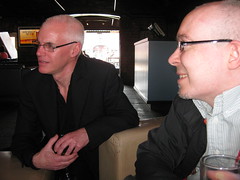
Warning: the following review is likely to be somewhat “biased”: When I first read Watchmen in my early twenties, it affected me as deeply as any work of fiction ever had—it changed my life. So my responses to the movie—as described below—are going to be more than a little colored by a highly personal connection to the source material. (Jason Horsley)
Watchmen, the movie, directed by Zack Snyder and adapted by David Hayter and Alex Tze, sticks remarkably close to the source material, the ground-breaking graphic novel written by visionary author Alan Moore (whose name isn’t on the film) and illustrated by Dave Gibbons. Moore is a self-confessed magician and uncontested genius of comic books, and his twelve issue, 300+ page superhero epic is a stupendously ambitious work, not merely one of the great accomplishments of comic book writing, but an outstanding work of fiction in any field. (It made
Time magazine’s 100 greatest novels—what more do you need to know?!)
When I first heard about the Watchmen movie, I was skeptical—to put it mildly. In fact, I was indifferent. And when I saw the first stills from the movie, I knew, absolutely knew, it was a bust, that they were turning it into something gaudy and noisy and messy and dumb—what Hollywood does best. Beyond all doubt, “the visionary director of 300”—a mind-numbingly vacuous live-action cartoon cum commercial for Spartan warfare—would debase the material by catering to the lowest sensibilities of the mass audience.

But within ten minutes or less of the movie, it’s clear that something else is happening. The film, like the graphic novel, starts with the murder of the Comedian. The perfect pre-credit sequence, it sums up the delicate resonance of the story by both keeping to genre conventions (for an opening action set-piece and plot-starting murder) while adding a whole new layer of emotional nuance and poignancy. The Comedian’s weary acceptance of his fate speaks volumes. He has been waiting for this moment, and he’s secretly relieved that it’s finally come. If he puts up a token resistance, it’s only because he doesn’t know how not to. He keeps up his end of the mythic narrative to the bitter end.
This is followed by the lovely, eerie frozen images of the credits, by which flesh and blood becomes comic book image, or vice versa. The credit sequence is inspired: both delightful—enchanting—and wryly amusing, it lets us know that we are in good hands and can settle back to enjoy the most fully satisfying and morally complex superhero enactment in the history of movies.
Watchmen is an authentic miracle of a movie—the best of its kind (the philosophical action fantasy) since
The Matrix came out ten years ago. (Plot wise,
Watchmen is less ingenious than
The Matrix, but morally it’s far more sophisticated.)
What’s really astonishing about this movie is that, in under three hours, it manages to capture not only the spirit of the novel but the full, epic breadth of its storyline. I’ve read the comic book at least a dozen times and yet I couldn’t even say which parts the movie misses out (except for the obvious, the parallel story within a story of “Tales of the Black Freighter”). The odds against a big budget Hollywood adaptation of a fiction masterpiece being almost 100% faithful, and at the same time managing to translate it whole into a new medium, are truly phantasmagorical.
Yet therein may be a problem: Watchmen is so completely true to its source that anyone not already enamored of the comic book may be unable to fully grok it. The storyline is straightforward enough, but the peculiar blend of social realism with the pulp roots of comics, and the idiosyncratic, poetic, magical genius of its creator, make Watchmen utterly unlike any superhero movie, or any movie, we've ever seen before. It’s a freak in the best sense of the word: a creature of unfathomable beauty so unique that some people may mistake it for ugliness. It creates its own aesthetic.

What’s perhaps most unusual about the film is its complete moral ambiguity, the way in which it steps entirely outside of the usual mythic paradigm of good and evil, spins off a parallel reality, and weaves its very own mythic narrative. Just as the graphic novel did within the comics field, Watchmen creates a new paradigm for the superhero movie. It’s a paradigm which I highly doubt other filmmakers will be willing, or able, to match, much less develop. There are no heroes in Watchmen, and no villains either. There are rather extraordinary (and extraordinarily flawed) human beings, struggling to make sense of a world in chaos, wrestling with their own complicity in that chaos. These are easily the richest and most affecting characters to ever grace what is ostensibly a fantasy movie. They are not just functions of the plot, as Neo and Morpheus are functions of the plot. As in all great writing, Watchmen’s story develops out of the characters and not vice versa. And these characters are nothing if not ambiguous.

The most dislikeable of the characters, Ozymandias, is driven by a seemingly pathological, philanthropist desire to save the world, and this he succeeds in doing. But we don’t admire him for it—we can’t admire him, because no end could justify these means. He’s an elitist, driven by intellect and a sense of his innate superiority, but devoid of heart. On the other hand, there is much to admire in the murderous vigilante Rorschach—who is all heart. His code of no compromise, his ruthless implacability, his deranged sense of justice, beneath which is a strange tenderness and a deeply wounded soul. Rorschach simply cares too much not to cause mayhem. Like Travis Bickle, his pain, rage and confusion spills out into the world—and he matches it atrocity for atrocity.

Dr. Manhattan, on the other hand, cares little for humanity’s plight: he’s moved beyond that. Was ever a god this chillingly disconnected, a superhero this utterly disaffected? Yet, as Billy Crudup (the only recognizable face in the movie) plays him, Dr. Manhattan is deeply touching. He’s human despite himself, and in his way he’s as lost a soul as the rest of these characters, because he is so utterly, completely alone. As written by Moore, Dr. Manhattan is the first fully believable depiction of a superhuman being—a god—in movies.

On the face of it, the Comedian is the most sheerly unpleasant of the characters: a rapist and child killer, the puppet of the military industrial complex (in a beautiful twist added by the moviemakers, he’s also JFK’s actual assassin). Yet, loathsome as his actions are, he doesn’t ever become hateful to us. None of the characters are defined—or limited— by their actions; they are far too alive for that. Moore’s genius is that he uses the very limited and limiting genre of the superhero comic as an arena—a sort of child’s playground, but also an alchemical workshop—to work through his philosophical themes and develop flesh and blood characters—like forging gold from lead. With Watchmen, he created a kind of feedback loop that expands the story from genre melodrama, into infinity—the realm of archetypes, of true myth. Paradoxically, by turning superhero archetypes into ordinary, believable human beings, ordinary beings are transformed into something extraordinary, something magical, transcendent.

Moore creates a world of impossible possibilities, and the movie recreates that world with breathtaking fidelity—the kind of loyalty and integrity that seems unimaginable in Hollywood, but that has somehow come to pass. Admittedly, the film does fail in one crucial area: that of mapping the endless series of synchronicities between images, words, events, that form the texture of the graphic novel, and that in a sense are what it’s really
about. More than the story, or even the characters,
Watchmen describes the texture and flow of mystery that living in a quantum universe entails, and what’s lacking in the film is the necessary plethora of fine details, of recurring motifs and themes. Besides that smiley face, I didn’t notice any repeating phenomena, and so the scenes aren’t woven together at this subtler, more esoteric level. The result, for those who aren’t familiar with the original story, may seem to be an almost straightforward, though complex, action movie; they may well miss the finer undercurrents moving beneath the gloriously gaudy surface.
There are other minor flaws: the sex scene to Leonard Cohen’s “Hallelujah” is something we could certainly have done without; perhaps more seriously, the extreme violence seems out of place here, largely gratuitous—it doesn’t add anything and may even detract from the dreamlike quality of the story (though with the Rorschach scenes a degree of savagery is probably intrinsic to the material). And sometimes what works in the graphic novel can seem mannered and contrived on screen (such as Night Owl’s question, “Whatever happened to the American Dream?”). Moore’s dialogue is often self-consciously clever, loaded, and this works better when we can hear it in our heads and give it our own inflexion. Actors can be all at sea with these multi-layered lines. There are also areas, such as Rorschach’s revealing the abyss of his soul to the liberal-minded psychiatrist, that need more time to be developed, that are rushed and hence diminished, and the film would probably have worked better, been less choppy and more textured, if it had been allowed an additional ten or twenty minutes of screen time.
But despite these flaws, the sheer joy and originality of the source material fills every frame. It animates every performance with an exuberance, audacity, and poetry, that is unique to the genre. I haven’t even begun to analyze the schizophrenic subtext of this film—perhaps another day?—but I can honestly say that, in thirty years of movie-going, I have never been so pleasantly surprised by a movie. Watchmen has every imaginable reason to crash and burn. Yet somehow, against impossible odds, it takes flight.

 Something very weird took place last Friday (17th April) and I am keen to record it here.
Something very weird took place last Friday (17th April) and I am keen to record it here.


















